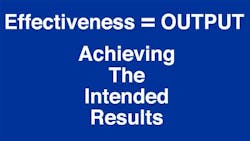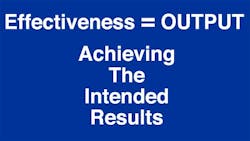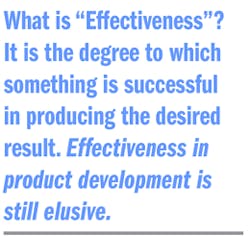Measuring Product Development Effectiveness
This file type includes high resolution graphics and schematics when applicable.
What is “Effectiveness”? It is the degree to which something is successful in producing the desired result. Effectiveness in product development is still elusive. Pharmaceutical companies believe they should get a larger percentage of trial drugs successfully through clinical trials. High-tech and consumer industries believe they should have better than a 90% failure rate. In general, industry average failure rates run around 40% to 50%. Yet, except for a small number of products where management just crosses their fingers, products approved into the pipeline are expected to create revenues. And, half or more of the time they do not.
Contrast this to current manufacturing operations in this day and age. Most plants have been running close to perfection for the past 30 years. They count defects in parts per million; and a good percentage of the work force has Six Sigma Black Belts to assure this remains the case. How different is that from product development!
Manufacturing operations have matured to the point where they are clearly effective and are successfully producing the desired results. That is why manufacturing is now focused on measuring productivity. Can manufacturing operations produce the same results (output) with less cost (input)? It is the right question for operations. It is not yet the right question for product development.
R&D, product development, product management, marketing, and select groups of other business functions are not yet mature enough to primarily focus on productivity. But, because of the success of this metric in mature business functions, senior management is forcing productivity metrics into every business function.
To fully make the point, let’s approach the subject from a different angle. Most established companies wish their annual revenues from new products were 30% to 45% or more of total sales. To achieve the hopeful 30% or 45%, they invest 3% to 15% of revenues back into R&D (aka R&D Spending) each year. In rough math, the expected multiplier that executives expect from R&D therefore ranges from a factor of 3× to a factor of 15×. The expected leverage from each R&D dollar spent is enormous. Most companies get only 5% to 25% of their actual revenues from new products and are always wishing they could do better. They are not achieving the planned output. Yet, too many wish to reduce the input when they get a 3 to 15× multiple per dollar spent.
How much more should a company spend to “save” a product that will otherwise die on the vine due to an overloaded pipeline? That “saved” product more than pays for any additional (unplanned) monies spent because of the multiple. Backing further upstream, how many approved products should a company not have approved so that fewer died on the vine? As well, how much of the time spent on vine-dead products could have been reallocated to the rest of the products in the pipeline to assure their success? Were any of the vine-dead products caused by subpar engineering or designer skill sets? What if the company spent a few extra thousand on training and it resulted in an additional product being saved and launched? Doesn’t that few extra thousand more than pay for itself? Any of these scenarios will result in higher pipeline yield and lower failure rates. At 3 to 15× revenue multiples, it would be cheap money spent.
These are but a few examples of places where the effectiveness of product development could be significantly improved. There are dozens more. Management will never ever reduce their demand for output. Therefore, because productivity is output divided by input, productivity in product development means reducing the input. Will less input cause product development to become more effective or more mature? Wouldn’t spending a bit more unplanned money when needed actually increase output which, in turn, would increase both effectiveness and productivity at the same time given multipliers of 3 to 15x?
About the Author
Bradford Goldense
Contributing Technical Expert
Bradford L. Goldense is founder and president of Goldense Group, Inc. [GGI] (www.goldensegroupinc.com), a consulting, market research, and education firm focused on business and technology management strategies and practices for product creation, development, and commercialization. He has been an adjunct faculty member of the graduate engineering school at Tufts University's Gordon Institute for 19 years. Goldense is a Certified New Product Development Professional [NPDP], a Certified Manufacturing Engineer [CMfgE], a Certified Computer Professional [CCP], and is Certified In Production & Inventory Management [CPIM]. He holds over 200 registered copyrights and is a recognized subject-matter expert, including appearances on PBS and CNBC. He has consulted to over 250 companies and over 750 manufacturing locations on four continents since founding GGI in 1986. Goldense holds an MBA in Accounting from the Cornell Johnson School and a BSCE from Brown University. For more information, please see Brad's LinkedIn profile or visit GGI's home page.




